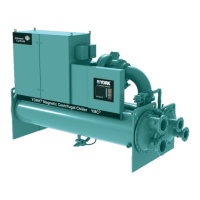FORM 160.84-EG1 (617)
JOHNSON CONTROLS
31
Application Data (Cont'd)
REFRIGERANT RELIEF PIPING
Each chiller is equipped with a dual pressure relief valve on the condenser and either a
dual relief valve on the evaporator, or a single relief valve on the evaporator if the optional
refrigerant isolation valves are ordered. The dual relief valve on the condenser is redun-
dant and allows changing of either valve while the unit is fully charged. The purpose of
the relief valves is to quickly relieve excess pressure of the refrigerant charge to the at-
mosphere, as a safety precaution in the event of an emergency such as a fire. They are
set to relieve at an internal pressure as noted on the pressure vessel data plate, and are
provided in accordance with ASHRAE 15 safety code and ASME or applicable pressure
vessel code.
Sized to the requirements of applicable codes, a vent line must run from the relief device
to the outside of the building. This refrigerant relief piping must include a cleanable, verti-
cal leg dirt trap to catch vent-stack condensation. Vent piping must be arranged to avoid
imposing a strain on the relief connection and should include one flexible connection.
SOUND AND VIBRATION CONSIDERATIONS
A YMC² chiller is not a source of objectionable sound and vibration in normal air condition-
ing applications. Optional neoprene isolation mounts are available with each unit to re-
duce vibration transmission. Optional level-adjusting spring isolator assemblies designed
for 1" (25 mm) static deflection are also available for more isolation.
YMC² chiller sound pressure level ratings will be furnished on request. Control of sound
and vibration transmission must be taken into account in the equipment room construction
as well as in the selection and installation of the equipment.
THERMAL INSULATION
No appreciable operating economy can be achieved by thermally insulating the chiller.
However, the chiller’s cold surfaces should be insulated with a vapor barrier insulation
sufficient to prevent condensation. A chiller can be factory-insulated with 3/4" (19 mm) or
1-1/2" (38 mm) thick insulation, as an option. This insulation will normally prevent con-
densation in environments with dry bulb temperatures of 50°F to 90°F (10°C to 32°C) and
relative humidities up to 75% [3/4" (19 mm) thickness] or 90% [1-1/2" (38 mm) thickness].
The insulation is painted and the surface is flexible and reasonably resistant to wear. It is
intended for a chiller installed indoors and, therefore, no protective covering of the insula-
tion is usually required. If insulation is applied to the water boxes at the job site, it must be
removable to permit access to the tubes for routine maintenance.
VENTILATION
The ASHRAE Standard 15 Safety Code for Mechanical Refrigeration requires that all
machinery rooms be vented to the outdoors utilizing mechanical ventilation by one or
more fans. This standard, plus National Fire Protection Association Standard 90A, state,
local and any other related codes should be reviewed for specific requirements. Since
the YMC² chiller motor is hermetically sealed, no additional ventilation is needed due to
motor heat.
In addition, the ASHRAE Standard 15 requires a refrigerant vapor detector to be em-
ployed for all refrigerants. It is to be located in an area where refrigerant from a leak would
be likely to concentrate. An alarm is to be activated and the mechanical ventilation started
at a value no greater than the TLV (Threshold Limit Value) of the refrigerant.

